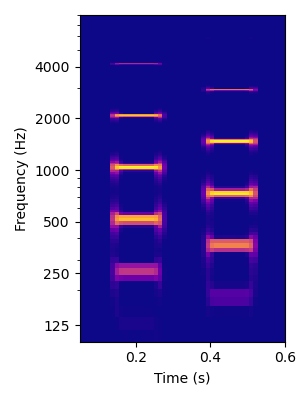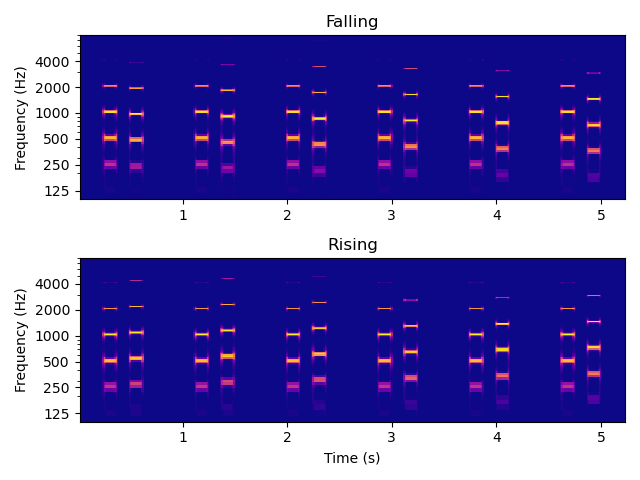"Shepard" tones are superpositions of pure tone components, in which the Nth tone has a frequency one octave above the (N-1)th tone (unlike you typical complex tone or harmonic complex, where the Nth tone is (N-1) octaves above a lowest common "fundamental" frequency.)
Shepard tones are interesting in that their pitch can be somewhat ambiguous, and this ambiguity can lead to curious perceptual phenomena. One phenomenon is that Shepard tones can be used to create continuous sounds known as "Shepard-Risset glissandos" which appear to be either continuously rising or falling in pitch. Another phenomenon is that the perceived pitch of Shepard tones can depend on the context in which they are presented. Here we present one demonstration of this context dependent pitch ambiguity that was studied in this paper by the group of Daniel Pressnitzer.
First consider this pair of Shepard tones. The components of the second complex are exactly half way between the components of the first complex. One could therefore perceive the two tone sequence either as a rising or a falling pitch step. There is no single "correct" answer. You may hear this as "clearly rising", while others may hear it as "falling" in pitch, and others may just be uncertain about the pitch change direction.
Listen to the tone pair a few times and make up your mind about what you think it sounds like before you move on:

Now consider two sequences, each consisting of six Shepard tone pairs. One distinguishing feature of the sequence labelled "Falling" from the one labelled "Rising" is that the first pair of the Falling sequence could be seen as either a small down step or a very large up step, and the reverse is true for the first pair of the Rising sequence. It appears that our brains will go with the "smaller step" interpretation, and pretty much all listeners will hear the first pair in the Failling sequence as being a small down step in pitch. The Falling sequence then continues with more pairs in which the downward pitch step becomes gradually larger. Similarly, the Rising sequence comprises increasinglingly larger up steps in pitch.
Now here comes the punchline: both sequences end in a pair in which the pitch step is exactly half an octave, and which is therefore intrinsically ambiguous. The last (6th) pair in both sequences is identical, and it is exactly the same tone pair that you have already encountered in isolation above. However, depending on whether this pair is presented in a context of either a falling or a rising sequence of pitch steps, the brain hears this sound pair very differently, as either "clearly falling" or "clearly rising" in pitch.

Falling:
Rising:
The idea that the same sounds can evoke very different pitches depending on the context in which they are encountered is challenging for people who, perhaps through musical training or otherwise, have been brought up to think that the perceived pitch of a sound should conform in an "objective" manner to some physical properties of the sound or the sound source, such as a fundamental resonance frequency. In reality, the pitch of a sound, perhaps not unlike the color of an object, is a subjective perceptual quality which is created by our brains, and while it is informed by the physical attributes of a given sound, it is not wholly determined by it.
